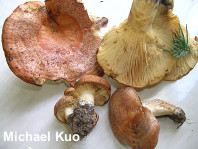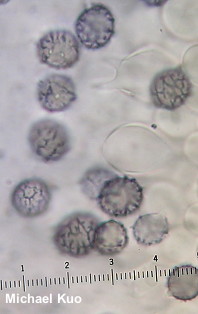| Major Groups > Gilled Mushrooms > Pale-Spored > Lactarius > Lactarius olympianus |

|
Lactarius olympianus [ Basidiomycota > Russulales > Russulaceae > Lactarius . . . ] by Michael Kuo Here is a gorgeous western Lactarius recognized by a combination of features:
Lactarius olympianus is reminiscent of several other species in the "Lactarius zonarius" group, including the eastern, hardwood-associated Lactarius psammicola and the European species Lactarius zonarioides. Thanks to the Sam Mitchel Herbarium of Fungi at the Denver Botanic Gardens for facilitating study of the Lactarius olympianus collection cited below. Description: Ecology: Mycorrhizal with high-elevation spruces; summer and fall; Colorado to the Pacific Northwest. The illustrated and described collections are from Colorado. Cap: 2–10 cm; convex with an incurved margin when young, becoming flat, shallowly depressed, or shallowly vase-shaped; slimy to sticky when wet; fairly bald; the margin not hairy, even when young; bright orange with concentric zones of paler orange. Gills: Attached to the stem or running down it; close or nearly distant; whitish at first, becoming yellowish or orangish; developing orangish brown to brown stains and discolorations. Stem: 2–5 cm long; up to 2 cm thick; more or less equal, or with a tapered base; dry or moist; without potholes; smooth; white; discoloring brownish to dingy orangish or yellowish where handled. Flesh: White; not changing when sliced, or developing rusty stains. Milk: White; not changing when exposed to air; staining the gills brownish to orangish brown. Odor and Taste: Odor not distinctive; taste strongly acrid. Chemical Reactions: KOH on cap surface negative. Spore Print: Reported as creamy white. Microscopic Features: Spores 7–10 x 8–11 µm; subglobose; ornamentation as amyloid warts and ridges 0.25–0.5 µm high, forming partial reticula. Pleuromacrocystidia not found. Cheilocystidia filiform to aciculate; to about 30 µm long. Pileipellis an ixocutis. REFERENCES: Hesler & Smith, 1979. (Smith, Smith & Weber, 1979; Phillips, 1991/2005; Trudell & Ammirati, 2009; Evenson, 2015.) Herb. DBG 24276. This site contains no information about the edibility or toxicity of mushrooms. |
© MushroomExpert.Com |
|
Cite this page as: Kuo, M. (2016, June). Lactarius olympianus. Retrieved from the MushroomExpert.Com Web site: http://www.mushroomexpert.com/lactarius_olympianus.html |

